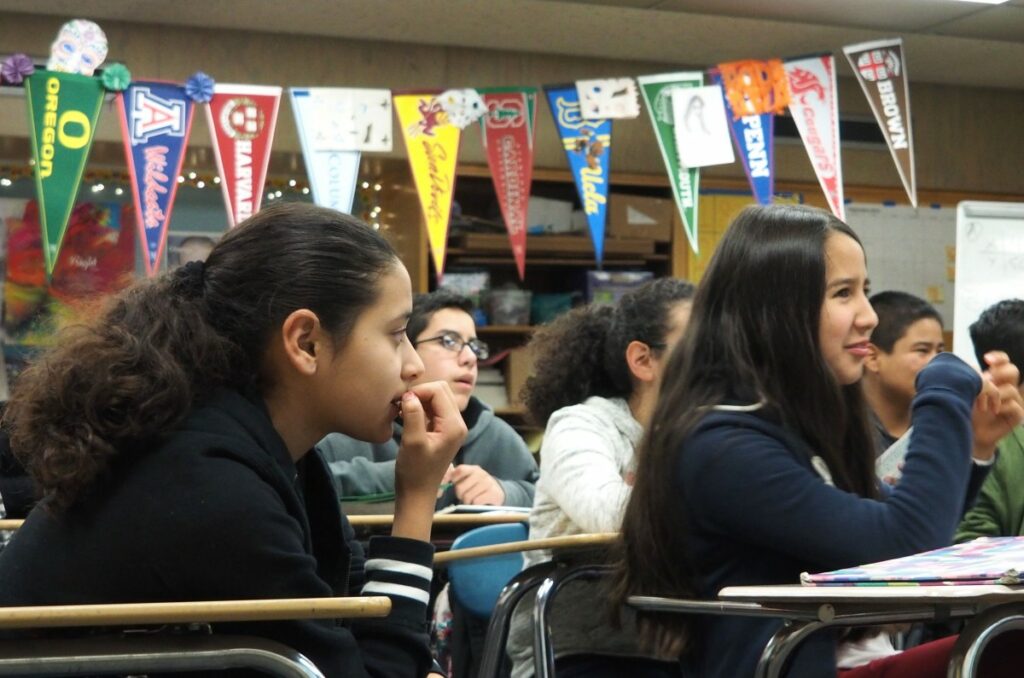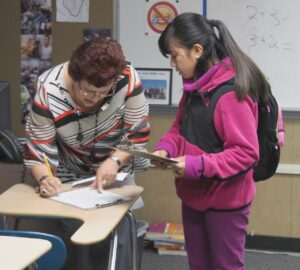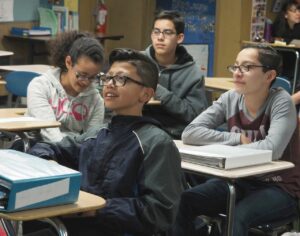
Black teachers: How to recruit them and make them stay

Lessons in higher education: What California can learn

Keeping California public university options open

Superintendents: Well-paid and walking away

The debt to degree connection

College in prison: How earning a degree can lead to a new life

The students giggle, squirm and whisper to each other as their instructor gets ready to begin. It’s the start of a typical middle school class except for one thing: these 12-year-olds are taking a college course.
Being college-ready has a new meaning at middle schools in Hayward Unified, where some 7th- and 8th-graders stay after school to take introductory college courses from local community college instructors. While many districts in California give high school students the opportunity to earn college credit, Hayward may be the only district in California – and possibly in the nation – to offer college courses to middle school students after school.
Instructors at Hayward’s Chabot College teach classes at the middle schools ranging from Early Childhood Development to Engineering to Music. Each of the five middle schools in the Bay Area school district offers one class per semester. Although the instructors adjust their teaching to be more appropriate for middle school students, the content is the same as courses offered at Chabot. The credits earned are transferable to community colleges and four-year universities.
Offering college classes for 12-year-olds might seem like another example of putting pressure on students at ever-younger ages, but the impetus for the program is quite different, Hayward administrators say.
Middle school occurs at a critical juncture for students, who face peer pressure as they try to form their own identity and envision their future. Hayward educates about 22,500 students, three-quarters of whom come from low-income families.
If they pass a college class and get credit, then “no one can tell them they’re not college material,” said Chien Wu-Fernandez, assistant superintendent of student and family services for Hayward Unified. “They have just proved that they are.”
Administrators in the district say that many of their students have no relatives or friends who have gone to college and are in danger of thinking or being told that college is not for them.

Liv Ames for EdSource Today
Seventh-grader Michelle Cruz talks with Chabot College instructor Nidia Sanchez-Rico after class.
If they pass a college class and get credit, then “no one can tell them they’re not college material,” said Chien Wu-Fernandez, assistant superintendent of student and family services for Hayward Unified. “They have just proved that they are.”
The district wanted to use after-school time to propel students ahead, rather than focusing only on remediation or support for classroom work, Wu-Fernandez said. “We thought, ‘What better way to promote college and career readiness?’”
Some students could possibly earn enough credits to graduate with a high school diploma and an associate’s degree, she said, but the primary purpose of the program is exposure to college work.
In queries sent to public information officers from California’s community colleges and directors of the state’s after-school programs, no one offered any other examples of middle school students taking college classes. Officials with national advocacy groups for expanded learning programs, such as the Afterschool Alliance and Jobs for the Future, also said say they knew of no similar program.
David Farbman, senior researcher for the National Center on Time & Learning, an advocacy group for expanded learning programs, was surprised to learn that middle school students were tackling college courses during their after-school program.
“As long as they can handle it, it’s good to challenge them,” he said. “You don’t want to push kids too hard, but given the right support, they can achieve at high levels.”
Classes average 20 students, but music and theater classes can be as large as 35 students. Students must spend 18 hours in class per unit, and most classes are for three units. On days when the students are not in class, the after-school staff helps them develop good study habits and complete their work for the college class.
“It’s college with support,” Wu-Fernandez said. “They’re not doing it on their own.”
Roberto Mendez, who coordinates the program for Chabot, said the college chooses courses the middle school students can handle. “They’re not taking calculus or chemistry,” he said.

Photo by Liv Ames/EdSource
Joahan Nieto, front, and classmates, left clockwise, Daniela Pelayo, Oscar Angulo and Ernesto Contreras, all 7th-graders, are taking a college course on early childhood education at Ochoa Middle School in Hayward.
Likewise, Hayward school staff members select the students carefully to make sure they are ready for the class, Mendez said. “The assumption is that they are upper-level students who need to be challenged.”
Vanessa Cormier is manager of Middle College for Chabot, the program that typically offers college classes to students in high school. She counsels faculty who are interested in teaching courses at Hayward middle schools.
“I want to make sure they understand the audience they are teaching,” she said. Middle school students, Cormier said, have a more active style of learning, not just physically but mentally, too. They also do better working in groups, she said.
Besides learning the course content, the students are also learning the soft skills, Cormier said, such as persistence and self-regulation. Teaching those skills is not new for college faculty, she added. “The majority of our students don’t come out of their home ready to live on their own.”
But not all faculty are a good fit for the program, Cormier said. In one case, an art instructor who came to Ochoa Middle School did not handle the students well. The class was cancelled, and the instructor will no longer teach middle school students, she said.
So far, the Chabot College classes offered to Hayward middle school students, typically worth three units, include:
The classes are funded by state and federal after-school program grants. The district pays Chabot $300 to $500 per student, depending on the course and cost of textbooks – about what it would cost the students to take the same class at the community college. The district charges students a $25 processing fee, but no students are turned away because their families can’t pay the fee.
Data from Chabot College show that for the first three semesters of the Hayward program – summer 2014, fall 2014 and spring 2015 – enrollment in the classes was 175, with some students taking more than one class. The students completed 72 percent of their classes with a grade of C or better.
These results demonstrate that Hayward students “will excel when given the opportunity,” said Superintendent Stanley Dobbs.
Wu-Fernandez said students who don’t pass a class are encouraged to try again the following year. Just taking the course helps them realize that college work is “much easier than they thought,” she said.
Students who took Early Childhood Development 56 this past fall semester at Ochoa Middle School said they signed up for the course to find out what college was like. Many of them are part of The Puente Project, a UC Berkeley program that focuses on helping educationally underrepresented high school students go to college. The Hayward program is a pilot to see if the project should expand to include middle school students.
The college course met for two hours every Tuesday and Thursday. During one class session with instructor Nidia Sanchez-Rico, students took turns reading aloud sections of the college textbook that were projected onto a screen – with some students tripping over words such as productivity, incompetence and psychosocial. Others read the material flawlessly.
Each week, Sanchez-Rico chose 20 words from the assigned chapter for the students to define and use in sentences to help them with the reading material, something she did not require of her college students.
“I provide more support for them,” Sanchez-Rico said of her middle school students.
After reading sections of the book, students discussed the content in small groups and later with the whole class. That day, the focus was on middle childhood – the age of the students. They talked about their own families and home environments.
At the start of the course, students were shy, Sanchez-Rico said. “But now they are talking and participating. They have confidence.”
The students were given a study guide before each test, the same guide given to her college students, she said. Her exams have easy, medium and tough questions, but she did not include the tough questions for the middle school students.
Her Hayward students, mostly 7th-graders, expressed enthusiasm for the course.
Michelle Cruz, dressed in a bright pink jacket, said she “learned lots of different things, such as the changes inside your body when you are pregnant and that the man affects the sex of the baby.”
The students had to write a paper on nature and nurture and a pamphlet encouraging mothers to breastfeed.
Although some of the students admitted that they did not do all the reading, Edith Perez kept up with the course.
“You have to read the book if you want a good grade,” she said. When she was working on the pamphlet encouraging mothers to breastfeed, her father expressed concerns about her being too young to learn such things, she said. But she convinced him she was ready.
Her father, Jaime Perez-Gonzalez, who began working in the fields when he was 5, told his daughter he was proud of her for doing well in a college class. Edith earned a B.
Now the owner of a window washing company, Perez said he and his wife are pleased with the program, which is helping Edith know what to expect from college.
“We’re 100 percent behind her,” he said. “She is my little baby and has surprised me. She is so focused.”

Panelists discussed dual admission as a solution for easing the longstanding challenges in California’s transfer system.

A grassroots campaign recalled two members of the Orange Unified School District in an election that cost more than half a million dollars.

Legislation that would remove one of the last tests teachers are required to take to earn a credential in California passed the Senate Education Committee.

Part-time instructors, many who work for decades off the tenure track and at a lower pay rate, have been called “apprentices to nowhere.”
Comments (13)
Comments Policy
We welcome your comments. All comments are moderated for civility, relevance and other considerations. Click here for EdSource's Comments Policy.
Gloria Ajayi 4 years ago4 years ago
Hello, I have a 7th grade son whom I am interested in registering him for college classes. I need more information about your school. I will appreciate if you can provide me with your contact for more details. Thank you.
Lee 6 years ago6 years ago
I home school my son and have spoken with him about taking college courses as soon as I feel he is ready. He is very confident and a good student. Next year he will be in 7th grade. After reading your interesting article, I can foresee him being ready to begin and it has helped me to get a better grasp of what to focus on this year to prepare him even more. Thank you.
Blanca Sandoval 7 years ago7 years ago
How my son can he get college classes in 8th grade?
David M Cordell 7 years ago7 years ago
This is total lunacy.
Shyla-Teʻhara Moore 7 years ago7 years ago
I live on the island of Maui and I would like to know how to take the college credits while iʻm in middle school. Can you please inform me on how to do this. Thank you.
JENNIFER DENTON 7 years ago7 years ago
This is fascinating!!! I stumbled on this article while researching at 9:51 pm on a Thursday night how to prepare my middle school students for college. I would love for my students in Brooklyn, NY to be afforded the same opportunity. Do you mind sharing any next steps with me. This is worth sharing and passing along. Thank you so much for publishing. Prayerfully, we can be the second middle school in the nation.
Stefanie 8 years ago8 years ago
I wish my school offered this. I am also taking college courses (actual college courses, from edx.org and coursea) and have been since I was 12. I just graduated 8th grade and I am taking a class on the EU and human rights from Katholieke Universiteit Leuven and a class on psychology from MIT. I find my formal school work and classes easy and boring, and courses such as these help challenge me. Hopefully other … Read More
I wish my school offered this.
I am also taking college courses (actual college courses, from edx.org and coursea) and have been since I was 12. I just graduated 8th grade and I am taking a class on the EU and human rights from Katholieke Universiteit Leuven and a class on psychology from MIT. I find my formal school work and classes easy and boring, and courses such as these help challenge me. Hopefully other schools will begin to offer classes such as these, although it’s unlikely.
June 8 years ago8 years ago
The program seeks to promote college education, but instead it's lessening it's value. I don't think it's fair that these kids get college credit for taking classes that are purposefully designed to be easier (a professor even says she did not include the though questions) while students in the college get credit for harder coursework. I appreciate the goal of the program, but the credit system is flawed. By giving students credit, you are reinforcing … Read More
The program seeks to promote college education, but instead it’s lessening it’s value. I don’t think it’s fair that these kids get college credit for taking classes that are purposefully designed to be easier (a professor even says she did not include the though questions) while students in the college get credit for harder coursework. I appreciate the goal of the program, but the credit system is flawed. By giving students credit, you are reinforcing the idea that college is so easy they could take classes at age 12. You are also degrading the efforts of college students. Instead, the program should promote the fact that the coursework is similar to that of college, but they should not gain credit.
Replies
Steven S 8 years ago8 years ago
What about Ohio’s College Credit Plus program that launched last year?
I am currently in eighth grade and I am enrolled in a college. I take classes there after school (and once I can drive I will be able to take them during the school day).
This is all of Ohio, not just my school. Ohio’s CCP program enrolls 7-12th graders in REAL college classes at REAL colleges with REAL college students. It’s truly amazing.
Chrysan Daniels 8 years ago8 years ago
Our daughter Destiny, has completed six units and is enrolled in this Spring 2016 college class offered at Bret Harte Middle School. We enjoyed reading your post and can confirm this program is incredible. Great support from Puente program and YEP.
Kathy Laidlaw 8 years ago8 years ago
This is incredibly exciting, and I applaud Chabot and Hayward Unified for creating this opportunity for middle school students. The motivation this is sparking in these young people can only benefit the rest of the student body.
Barbara Oliver 8 years ago8 years ago
This is so awesome; the kids of Hayward! I hope it catches on for other school districts.
Jack 8 years ago8 years ago
This is more evidence that 12 or more years of school before college is just a jobs program for those in the school business..